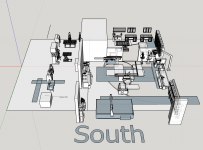locaholic35
Member
- Joined
- Oct 18, 2014
- Messages
- 38
I've enjoyed reading other users builds on here and look forward to sharing my own. My wife and I will be moving from San Francisco/Bay Area to Utah upon the completion of a house that we are designing.
Currently I work out of my narrow garage and I am excited about the opportunity to build a dedicated workshop and I am hoping for feedback and suggestions.
If it were up to me, I would have a tiny little sleeping area/kitchen and an enormous barn as a workshop, but since I am married and we are planning on a few kids, I unfortunately need to be a bit more realistic. As of now it is looking like the house and barn/workshop will be similar in size.
My wife is an interior designer with a background in spec homes, so one valid requirement is that the workshop space is somewhat usable for a future buyer. Thus, we are attempting to design it in a way that a future buyer could use it as a play/ half court basketball or parking for an RV and or boat. This will require ceiling heights slightly higher than what I would consider ideal, but if it allows for me to build a great shop than I am more than willing to sacrifice. This means that we are looking at roughly a 2500 sq/ft.
This will be a mixed use space where I will be doing woodworking, finishing (in a small finishing room) and metal work. I hope to separate the wood and metal work with distance and a physical barrier to prevent fire risks and cross contamination in general.
Ive attached a very early sketchup model that I have used to try and determine minimum space requirements.View attachment 1
Thanks for reading
Anthony
Currently I work out of my narrow garage and I am excited about the opportunity to build a dedicated workshop and I am hoping for feedback and suggestions.
If it were up to me, I would have a tiny little sleeping area/kitchen and an enormous barn as a workshop, but since I am married and we are planning on a few kids, I unfortunately need to be a bit more realistic. As of now it is looking like the house and barn/workshop will be similar in size.
My wife is an interior designer with a background in spec homes, so one valid requirement is that the workshop space is somewhat usable for a future buyer. Thus, we are attempting to design it in a way that a future buyer could use it as a play/ half court basketball or parking for an RV and or boat. This will require ceiling heights slightly higher than what I would consider ideal, but if it allows for me to build a great shop than I am more than willing to sacrifice. This means that we are looking at roughly a 2500 sq/ft.
This will be a mixed use space where I will be doing woodworking, finishing (in a small finishing room) and metal work. I hope to separate the wood and metal work with distance and a physical barrier to prevent fire risks and cross contamination in general.
Ive attached a very early sketchup model that I have used to try and determine minimum space requirements.View attachment 1
Thanks for reading
Anthony

